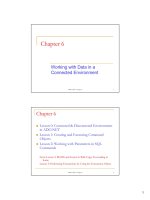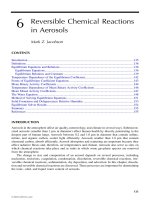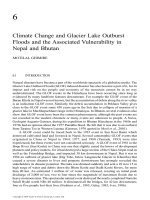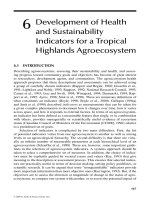Assessment in counseling chapter 6
Bạn đang xem bản rút gọn của tài liệu. Xem và tải ngay bản đầy đủ của tài liệu tại đây (134.45 KB, 18 trang )
Initial Assessment in Counseling
Chapter 6
Information Gathered in Initial Interview
∗
Demographic Information
∗
Client Background Information
∗
Health and Medical History
∗
Client’s Presenting Concern(s)
∗
Other Relevant Information
Defining the Client’s Problem
1.
2.
3.
4.
5.
Explore each significant problem from multiple perspectives
Gather specific information on each major problem
Assess each problem’s intensity
Assess the degree to which the client believes each problem is changeable
Identify methods the client has previously used to solve the problem
Assessing the Change Process
Prochaska et al.’s Transtheoretical Model:
1.
2.
3.
4.
5.
Precontemplation
Contemplation
Preparation
Action
Maintenance
Interviewing Skills and Techniques
∗
Consider credibility: Does counselor appear trustworthy, expert, attractive?
∗
Open-ended vs. closed-ended questions
∗
Commonly used techniques: Paraphrasing, clarifying, reflecting, interpreting, summarizing
∗
Verbal and nonverbal behaviors
Interviewing Children
∗
∗
∗
∗
∗
∗
∗
∗
Establish rapport and familiarity
Adjust questions to child’s developmental level
Ask questions in a warm professional manner
Explain reason for asking questions
Define limits of confidentiality
Structure interview to be developmentally appropriate (use physical props, games, toys, etc.)
Use variety of question types; avoid abstraction
Do not stop child’s disruptive behavior too quickly; observe
Types of Interviews
∗
Structured: established set of questions asked in same manner and sequence to each client
∗
Unstructured: counselor has idea of possible items but conducts interview in a unique manner
depending on the client’s needs
∗
Semi-structured: combination of structured and unstructured; certain questions are always
asked, but there is room for exploration and additional questions
Other Strategies Used in Initial Assessment
∗ Checklists
∗
∗
Standardized
Informal
∗ Rating scales
∗
∗
Standardized
Informal
Assessment of Suicide Potential
∗
∗
∗
Suicide is 10th leading cause of death in the U.S. (NIMH, 2010)
71% of counselors have worked with individuals who had attempted suicide; 28% of those
practitioners had a client who had committed suicide (Rogers et al., 2001)
Risk factors vs. warning signs
Assessment of Suicide Potential: Warning Signs & Risk
Factors
Warning Signs
∗
∗
∗
Imminent or pressing danger; individual
should be evaluated for possible
intervention
Tier 1
Tier 2 (Rudd et al., 2006)
Risk Factors
∗
General picture indicates long-term risk
for suicide attempt
Assessment of Suicide Potential
∗
Risk factors often associated with demographic characteristics
∗
Adolescent suicide - 3rd leading cause of death among 15-24 year olds
∗
∗
∗
Gender
Age
Race/ethnicity
Assessment of Suicide Potential
∗
Other factors:
∗
∗
∗
∗
∗
∗
∗
∗
Drug/alcohol use
Depression – hopelessness/helplessness
Previous attempts
Recent loss, divorce, or separation
Personality factors
History of psychiatric disorder
Personality disorder
“Protective” factors
Assessment of Suicide Potential
∗ Suicide Potential Instruments:
∗
∗
∗
∗
∗
Suicide Probability Scale (Cull & Gill, 1992)
Beck Scale for Suicide Ideation (Beck & Steer, 1991)
Beck Hopelessness Scale (Beck & Steer, 1993)
Suicidal Ideation Questionnaire (Reynolds, 1988)
Adult Suicidal Ideation Questionnaire (Reynolds, 1991)
Assessment of Depression
∗
∗
∗
∗
Assess level of depression with every client (Morrison, 2007)
Know the symptoms – cognitive, affective, behavioral/ physical
Assess severity and type of depression
Some formal instruments:
∗
∗
∗
∗
Beck Depression Inventory-II (Beck, Steer, & Brown 1996)
Children’s Depression Inventory-2003 Update (Kovacs, 2003)
Children’s Depression Rating Scale-Revised (Poznanski & Mokros, 1996)
Hamilton Depression Inventory (Reynolds & Kobak, 1995)
Assessment of Substance Abuse
∗
∗
∗
In most mental health settings, 29% - 50% of individuals seeking services will also have substance use
disorder (Adesso et al., 2004)
Assessing substance use is needed throughout counseling process if counselor detects possibility of
problem
Explore alcohol use and drugs taken (prescription, over-the-counter, street drugs)
∗
∗
∗
Substances used & amount taken
Social & interpersonal aspects
Internal & external triggers
Assessment of Substance Abuse: Methods & Instruments
∗
Motivational Interviewing
∗
∗
4 general principles: express empathy, develop discrepancy, roll with resistance, support self-efficacy
Substance Abuse Subtle Screening Inventory 3 (SASSI-3)
∗
SASSI-A2 for adolescents
Assessment of Substance Abuse: Methods & Instruments
∗
CAGE interviewing technique (Mayfield, McLeod, & Hall 1974)
1. Have you ever felt you need to cut down on your drinking?
2. Have people annoyed you by criticizing your drinking?
3. Have you ever felt bad or guilty about drinking?
4. Have you ever had a drink first thing in the morning to steady your nerves or get rid of a hangover
(eye opener)?
∗
“acid test” method
Mental Status Examination
(Polanski & Hinkle, 2000)
∗
∗
∗
Used to describe client’s level of functioning and self-presentation
Generally conducted during initial session/intake interview
Usually organized around: (Trzepacz & Baker, 1993)
∗
∗
∗
∗
∗
∗
Appearance, attitude, and activity
Mood and affect
Speech and language
Thought process, thought content, and perception
Cognition
Insight and judgment









